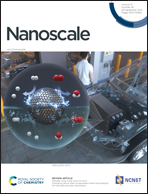Flexible nanoporous activated carbon for adsorption of organics from industrial effluents†
Abstract
This paper reports a study involving the formation of a self-assembled polymeric monolayer on the surface of a high surface area activated carbon to engineer its affinity towards organic contaminants. A nanoporous activated carbon cloth with a surface area of ∼1220 m2 g−1 and a pore volume of ∼0.42 cm3 g−1 was produced by chemical impregnation, carbonisation and high-temperature CO2 activation of a commercially available viscose rayon cloth. The subsequent modification with a silane polymer resulted in a nanoscale self-assembled monolayer that made it selective towards organic solvents (contact angle <10°) and repellant towards water (contact angle >145°). The adsorbent showed more than 95% efficiency in the separation of various types of oil/water mixtures under neutral, basic and acidic conditions. Benefiting from inherent nanoscale features, a robust hierarchical structure and a thermally stable monolayer (∼300 °C), this nanoporous adsorbent maintained high efficiency for more than 20 cycles and separated surfactant stabilised emulsion with >92% oil removal efficiency. The adsorbent was studied extensively with a series of advanced characterisation techniques to establish the formation mechanism and performance in emulsion separation. Findings from this work provide crucial insights towards large-scale implementation of surface engineered activated carbon-based materials for a wide range of industrial separation applications.



 Please wait while we load your content...
Please wait while we load your content...